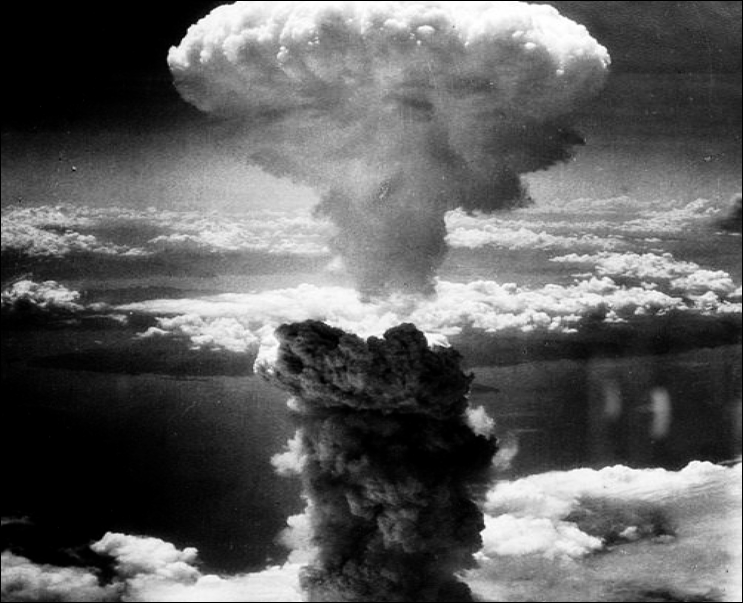Winner of the Spring 2017 StMU History Media Awards for
Best Article in the Category of “World History”
“We knew the world would not be the same. A few people laughed, a few people cried, most people were silent. I remembered the line from the Hindu scripture the Bhagavad Gita. Vishnu is trying to persuade the prince that he should do his duty and to impress him takes on his multiarmed form and says, ‘Now, I am become Death, the destroyer of worlds.’ I suppose we all thought that one way or another.”1
- J. Robert Oppenheimer, The Decision to Drop the Bomb

Throughout the history of human warfare, conflict has pushed humans to innovate–to build ever larger and deadlier weapons, each more lethal than the last. However, it was not until World War II and the invention of the atomic bomb that humanity has been able to kill on such a massive and efficient scale. Case in point, in the final days of World War II, the United States carried out one of the most chilling instances of mass murder in the history of humanity: the bombing of the Japanese cities of Hiroshima and Nagasaki. These attacks ultimately killed an estimated 294,000 people, the majority of whom were noncombatants.2 In comparison, the Japanese attack on Pearl Harbor killed just 2,408 American citizens, although this is largely due to the focused Japanese attack on military targets, namely the Pacific fleet and U.S. airfields.3 To give a more modern frame of comparison, the terrorist attacks against the World Trade Center and Pentagon, considered to be by far the worst terrorist attacks against the United States, claimed the lives of 2,974 American citizens.4
In the spring of 1945, World War II was entering its final stages. The Allies had already achieved victory in Europe with Germany’s surrender on May 7th, but the conflict on the Pacific front was still going strong. In the years leading up to the two World Wars, Japan’s victories against two larger countries–China in the Sino-Japanese War (1894–1895) and Russia in the Russo-Japanese War (1904–1905)–combined with other factors, forged a strong sense of Japanese nationalism, militarism, and cultural superiority. This fervent nationalism, integrated with the Japanese warrior ethic known as bushido, made the prospect of a Japanese surrender unlikely, even as the Allies began to position for an invasion of the Japanese mainland.5

Concurrently, since as early as 1942, President Franklin Delano Roosevelt had been secretly sponsoring and funding The Manhattan Project, the code name used for the $2 billion U.S. effort to develop a nuclear weapon before the Germans. A team of top physicists led by Dr. Julius Robert Oppenheimer were assigned to this project, a task so secret that not even individuals as important as then Vice President Harry S. Truman was aware of it. Shortly after Roosevelt’s untimely death and Truman’s subsequent inauguration to the presidency in April 1945, he was informed that the Manhattan Project was approaching success–that a nuclear weapon would be feasible in just four short months.6
Faced with the prospect of a costly and deadly invasion of Japan, Truman and his advisors were faced with a difficult choice: utilize this new atomic weapon or try to defeat Japan through conventional means. In late July, the United States issued the Postdam Declaration, a statement which gave Japan the choice between unconditional surrender or total annihilation. When this declaration went ignored, President Truman authorized the use of the atomic bomb.7

On the morning of August 6, 1945, Colonel Paul Tibbets piloted the Enola Gay over the city of Hiroshima, where his crew dropped an atomic bomb code-named “Little Boy.” Upwards of 70,000 people died instantly in the blast. Additionally, 48,000 buildings were destroyed and another 22,000 were damaged, leaving only 6,000 buildings untouched. Three days later, on August 9th, a second bomb was dropped onto Nagasaki, killing another 36,000 people. In total, an estimated 295,000 were killed in the blasts or from complications from the resulting nuclear fallout.8
Emperor Hirohito ordered the surrender of Japan on August 10, 1945. On August 15th, radios across Japan broadcasted Hirohito’s words as he read the declaration of surrender to the Japanese people, thus ending World War II. The bombs’ effectiveness in forcing the Japanese to surrender is still subject of popular debate among historians to this day, given that the Russian invasion of Japan-controlled Manchuria occurred at the same time of Nagasaki, both of which likely impacted Japan’s will to continue fighting.9 Even so, while the political and military effects of these blasts may be debated, none can contest their tragedy and devastation.

- Jason Pontin, “Oppenheimer’s Ghost,” MIT Technology Review, October 15, 2007. https://www.technologyreview.com/s/408835/oppenheimers-ghost/. ↵
- Dennis W. Cheek, “Hiroshima and Nagasaki,” in Encyclopedia of Science, Technology, and Ethics, edited by Carl Mitcham, Vol. 2, Detroit: Macmillan Reference USA, 2005. Gale Virtual Reference Library (accessed February 6, 2017), 923. ↵
- Sonia Benson, Daniel E. Brannen, Jr., and Rebecca Valentine, “Pearl Harbor Attack,” in UXL Encyclopedia of U.S. History, Vol. 6, Detroit: UXL, 2009. Gale Virtual Reference Library (accessed February 6, 2017), 1208. ↵
- Stefan M. Brooks, “September 11 Attacks,” in The Encyclopedia of Middle East Wars: The United States in the Persian Gulf, Afghanistan, and Iraq Conflicts, edited by Spencer C. Tucker, Vol. 3, Santa Barbara, CA: ABC-CLIO, 2010. Gale Virtual Reference Library (accessed February 6, 2017), 1096. ↵
- “The United States Drops the Atomic Bomb on Hiroshima and Nagasaki,” in Global Events: Milestone Events Throughout History, edited by Jennifer Stock, Vol. 2, Asia and Oceania, Farmington Hills, MI: Gale, 2014. Gale Virtual Reference Library (accessed February 5, 2017), 361. ↵
- “An Overview of the Atomic Bombings of Hiroshima and Nagasaki,” in The Atomic Bombings of Hiroshima and Nagasaki, edited by Sylvia Engdahl, Perspectives on Modern World History, Detroit: Greenhaven Press, 2011. Gale Virtual Reference Library (accessed February 6, 2017), 13-14. ↵
- “An Overview of the Atomic Bombings of Hiroshima and Nagasaki,” in The Atomic Bombings of Hiroshima and Nagasaki, edited by Sylvia Engdahl, Perspectives on Modern World History, Detroit: Greenhaven Press, 2011. Gale Virtual Reference Library (accessed February 6, 2017), 14-15. ↵
- Dennis W. Cheek, “Hiroshima and Nagasaki,” in Encyclopedia of Science, Technology, and Ethics, edited by Carl Mitcham, Vol. 2, Detroit: Macmillan Reference USA, 2005. Gale Virtual Reference Library (accessed February 6, 2017), 923. ↵
- “The United States Drops the Atomic Bomb on Hiroshima and Nagasaki,” in Global Events: Milestone Events Throughout History, edited by Jennifer Stock, Vol. 2, Asia and Oceania, Farmington Hills, MI: Gale, 2014. Gale Virtual Reference Library (accessed February 5, 2017), 361. ↵



152 comments
Raymond Davila
This article informed me about some of the reason as to why Japan was still in strong conflict against america and hadn’t surrendered even after the victory in Europe. It also informed me as just how many people died during both the bombings of Hiroshima and Nagasaki. This also shows just how difficult the decision Truman made was because just a few simple words ended the lives of nearly 300,000 lives.
Benjamin Arreguin
I like how in depth the article was, one thing I took away from this article is how scary this could still be applied today. These threats still occur today, and in today’s time, and could even be worst with today’s policies and decisions. Nuclear warfare is no joke, and this article covers the seriousness about issues regarding these problems and how out of control things can get. Death rates were too high not to reconsider how we reconstruct our nuclear missile policies and how loosely we throw our power around compared to other powerhouses, I enjoyed this informational article.
Christopher King
This is a well written article that seems to keep from having a biased opinion on the debate over whether or not it was the right thing to do to drop the atomic bomb. Personally I agree with the decision because in the long run it saved the country of Japan from being completely destroyed and saved possibly millions of lives. Also, the Japanese did much worse in cities of China when they murdered nearly 300,000 in one city alone in three days. I am sure it is safe to say that it was necessary to end the war and save lives.
Kailan Pena
I completely disagree and abhor the idea of nuclear warfare and it is so shameful that we had to resort to dropping an atomic bomb on Japan. The government knew it was doing wrong and clearly tried to keep the whole Manhattan Project under wraps because they knew it was wrong. I’m glad this article was written and written well at that, it provides a lot of information regarding this horrible moment in history.
Isaac Rodriguez
A commonly debated argument is whether former president Truman should’ve bombed Hiroshima and then Nagasaki. Many believe that bombing Japan was wrong, because of the damage it caused to its infrastructure and citizens. A popular argument from the against side is that Truman should’ve detonated the second bomb in the ocean to demonstrate our nuclear capabilities, rather than in a major city.
Hannah Wilson
I think it is wrong that our President would be willing to hide something so extreme from almost everyone. I understand that Roosevelt and Truman were both trying to save the lives of as many Americans and troops as they could. The two atomic bombs killed 295,000 Japanese civilians, but also could have saved many other people in the result. However, it is hard to imagine if it was really worth it. It is a heartbreaking moment in history, and it always will be.
Aaiyanna Johnson
I find it very intriguing of how this discovery changed everything. This caused so many other countries to gain and create their own weapons of massive destruction. I really enjoyed your well detailed article. It touched on so many great topics. Although I knew of this topic already it’s as if I just learned of it. The subject of bombs in general is a hard topic, but one which should be discussed.
Mariah Cavanaugh
Dropping the nuclear bomb over Hiroshima is a shameful moment in America’s history. In your article, you stated that a majority of the 294,000 people killed as a result of the bomb were noncombatants. The fact that we as Americans were willing to kill so many innocent people is tragic. To this day, children are born with disabilities and physical deformities that stem from the nuclear bomb the U.S dropped. I recently watched an upsetting documentary about an orphanage that cares for those children.
Abigale Carney
Very informative article! I didn’t know that the atomic bombs had a code name. The Manhattan project was probably one of the most deadly project in world history. The ability to create such a weapon is very threatening to me, and the thought of such a weapon makes me a little concerned too. Although this allowed WWII to end in America’s favor, many lives were lost due to this weapon and this article reassured me of the danger of nuclear warfare.
Brianda Gomez
The Manhattan project was the code name to the deadliest weapon in the world. During world war 2, Japan attacked the United States at Pearl Harbor. The U.S. was not just going to stand down and to nothing about it. They wanted Japan to surrender and pay for what they did to our country. The bombings killed many people in 2 of the largest cities in japan. The atomic bomb is something so controversial that will be remembered in history forever. I really enjoyed reading this article. It was very interesting and well written.